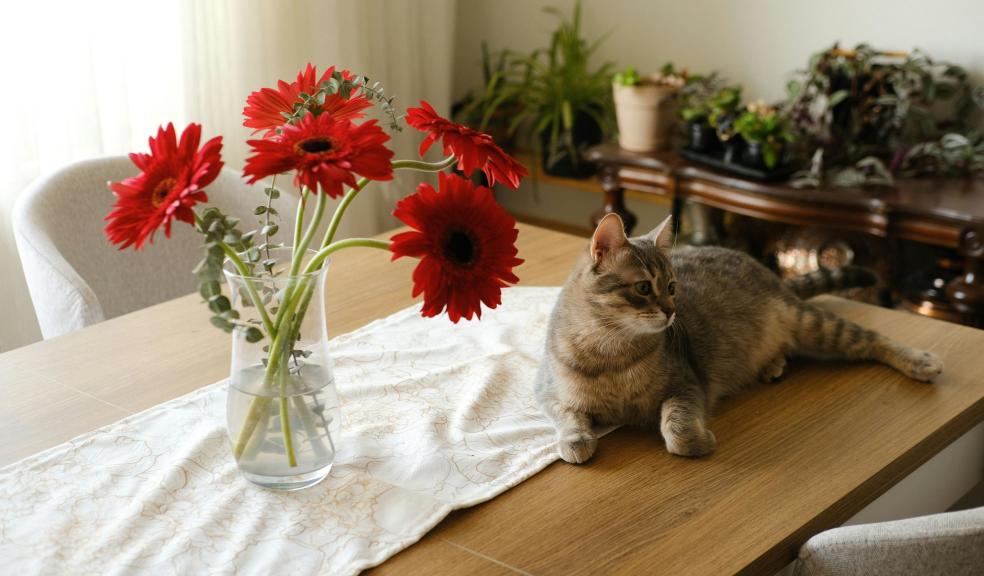
Vets issue urgent warning over popular home décor that could kill your pet
Emergency vets have issued an urgent warning to pet owners against the dangers of flowers in the home - revealing that drinking water from a vase of lilies could be enough to kill your cat.
With spring fast approaching, many of us will be choosing to decorate our home with seasonal flowers - including lilies, daffodils, and tulips. The Easter Bank Holiday will also likely see a flurry of floral bouquets.
Cats and dogs are natural carnivores but may nibble at plants because they enjoy the taste, are stressed, bored or feeling playful.
The professionals at Vets Now say it is imperative that pet owners educate themselves on the 11 toxic and dangerous plants found within our home or garden - before it's too late.
Vets Now head of telehealth, Dave Leicester, who is responsible for a team of experienced vets at Vets Now's Video Vets Now service and supports emergency clinicians at Vets Now's 60+ clinics and hospitals throughout the UK said: -
"Spring flowers can bring a touch of the outside into homes, but when not kept out of easy reach from pets they can prove to be a hidden hazard with life-threatening consequences for pets. We recommend that pet owners get to know the flowers which pose the highest risk - as there are some that are so dangerous, we'd call on owners to never have them in their house. However pretty they might be, it's not worth the risk."
************************************
Lilies: One in five toxic plant cases in pets are due to lilies. Certain types of lilies – those from the Lilium or Hemerocallis species – are very, very dangerous for cats. These include Asiatic, Day, Easter, Japanese Show and Tiger lilies. All these flowers contain highly toxic substances and chewing on leaves, or even drinking water from a vase containing them, can be potentially fatal for a cat. No parts of the plants are safe and cats have even been known to swallow a toxic amount of pollen just by grooming themselves after brushing against the flowers.
Daffodils: These yellow plants may feel like the flower of the spring season, but they contain a poisonous alkaloid that can trigger vomiting, while the bulbs are severely toxic and can lead to serious conditions such as heart rhythm abnormalities or breathing problems.
Amaryllis: The stalks, flowers and bulbs of this plant all contain phenanthridine alkaloids, which are toxic to pets. The highest quantity of this can be found in the bulbs and eating amaryllis can cause vomiting, changes in blood pressure, tremors, and seizures.
Tulips: The bulbs of this popular flower are the most toxic bit but sadly any part can pose a threat to your pet and should be kept well out of reach. The allergenic lactones found in tulips can lead to vomiting, diarrhoea and depression if swallowed.
Chrysanthemums: These flowers are mildly toxic to dogs, but they contain pyrethrins, which can be found in flea and tick medications and are very poisonous to cats. Look out for vomiting, diarrhoea, and lack of appetite if your pet has eaten chrysanthemums and seek advice from your vet.
Hyacinths: Once again, the highest concentration of poison found in this plant is in the bulb and consuming it can lead to drooling, vomiting, or diarrhoea for your pet.
Iris and gladioli: Both flowers can cause irritation to your pet when eaten and like many popular spring flowers, the most amount of poison can be found in the bulb.
Cyclamen: This popular houseplant is often found in Mediterranean countries and contains saponins, which are irritating. Eating cyclamen can lead to sickness, diarrhoea and potentially even heart failure if ingested in large enough quantities.
Widow's thrill: Also known as Kalanchoe, this plant is toxic to dogs and cats, and may cause them to vomit or suffer with diarrhoea. The toxins found in this plant have also been known to cause abnormal heart rhythms.
Foxglove: Foxgloves are famed for their trumpet-like blossoms but are sadly very poisonous to dogs, cats, and even humans. They contain naturally occurring poisons, called cardiac glycosides, that affect the heart.
Crocus: Both types of crocus plant – the spring crocus and the autumn crocus – are dangerous to pets. The spring crocus can cause gastrointestinal issues, which include vomiting and diarrhoea if ingested. All parts of the autumn crocus are highly toxic and can cause severe symptoms, which include vomiting, bloody diarrhoea, gastrointestinal bleeding, liver and kidney damage, respiratory failure, seizures and potentially even death. You may see signs instantly but, in some cases, they take days to appear.
Vets Now is available 24-hours a day, seven days a week, with clinics across the UK.
If you're unsure whether your pet needs veterinary treatment, you can book an online video consultation with Video Vets Now. If you know for certain your pet has eaten something toxic, however, do not delay, call your daytime vet or your local emergency clinic.
For more helpful pet owner advice and information, or to find your nearest clinic, visit www.vets-now.com.







